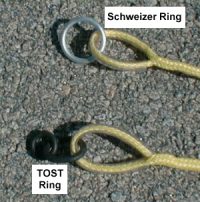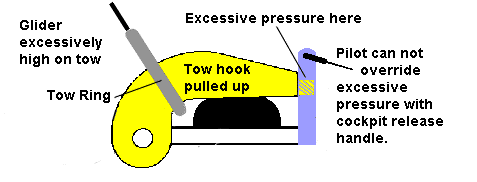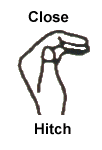Introduction
Connecting the towline is one of the most important tasks that the wing runner will be required to accomplish. If this task is completed in a careless or incorrect manner, it could cause the glider to experience a premature release from the tow plane or prevent a release of the towline. Either of these abnormal occurrences will result in a potential emergency for the pilots of the glider and the tow aircraft. The following sections review the requirements for, and potential problems associated, with attaching the towline.
Preparation
The wing runner may be required to check the towline before aero tow operations begin. The correct procedure for completing this task is included in Assisting the Pilot with Pre-Flight Preparations – Checking the Towline.
Safety
A typical sequence of events involves the following steps: The tow pilot will taxi the tow plane into position in front of the glider. The towline will be positioned close to the glider but with enough slack to permit it to be attached. It is a common practice to hold the towrope and assist the positioning while the tow plane is still taxiing forward. This should only be done using a rope hook. Once the tow plane has stopped and when requested by the glider pilot, the tow ring can be attached to the glider tow hitch.
This sequence of events occurs during a period of time in which a number of potential hazards exist. For example, the tow plane is being taxied in close proximity to the glider as the wing runner approaches the tow plane to pick up the towline. It is vital for the wing runner to be aware of these potential hazards and to maintain a safe distance from moving aircraft, especially the area around the propeller. Stay behind the wing of the towplane.
As the tow plane approaches with engine running, the nose of the tow plane partially obscures the forward view of the tow pilot. It is vitally important to keep well clear of the tow plane while it is moving. Only approach it from behind the wings. If it is necessary to go to the cockpit, wait for the tow plane to stop.
Picking up the towline while it is moving risks rope burn if the rope slides through the hands. This type of injury can be prevented by always using a rope hook to hold the rope. Additionally, entanglement is always a possibility with a moving towline. Stand well clear of the towline as the tow plane taxies forward to prevent legs and arms from being caught in a tangled towline. Do not let the towline run through the hands or around the body. Always hold the towline or rope hook in a manner in which it can be easily released if the rope snatches.
Glider Tow Hitches
At the glider end of the towline are the attachment ring(s). The type of tow hitch fitted to the glider determines the proper type of ring(s). The wing runner needs to be familiar with the requirements of the glider to ensure that the correct ring(s) are used. Using the wrong type of ring(s) may result in the towline hanging up and failing to release from the glider.
Generally, there are two different types of tow hitch and tow ring(s) in use. The Schweizer tow hitch is an “L” shaped hook and is primarily fitted on gliders produced by the Schweizer Aircraft Corporation. These hitches use a single round tow ring. Nearly all other gliders are fitted with a Tost tow hitch. The Tost hitch is a hook mounted inside a round metal ring. Tost tow hitches use tow rings that are specially designed for the Tost hitch. The Tost unit is comprised of an oblong ring and a round ring looped through each other. The round ring is attached to the tow hitch.
A few gliders use other systems requiring a special tow ring. Because these rings may not be commonly available, pilots normally carry the tow rings in their gliders and provide them for use by the launch crew.

The Schweizer ring is too large to fit the Tost hitch, but Tost rings can be fitted to the Schweizer hitch. Because the Tost ring is not compatible with the Schweizer hitch, the tow hitch may jam. Consequently, Tost rings should not be attached to the Schweizer hook. If unsure of the correct tow ring(s), ask the glider pilot.
A typical glider operation will have some gliders that use the Schweizer tow hitches and others using Tost hitches. This means that a system for changing over between the different types of rings will need to be established. There are many different methods for doing this at different glider operations. The wing runner will need to be familiar with the system in use at the local operation and to know how to change over the rings.
Glider Tow Hitch Location
As previously stated, different gliders have different tow hitches that require different tow rings. Additionally, the tow hitches on different gliders may be fitted in different locations. The wing runner must know where the tow hitch is located.
To complicate matters further, some gliders have two tow hitches, typically one located in the nose, used for aero towing, and the other on the belly close to the center of gravity (CG), just forward of the main wheel, used for ground launching with a winch or tow car. It is vitally important that the towline be attached to the correct hitch. If any doubt exists as to which tow hitch should be used, be sure to ask the pilot of the glider.

Tow Plane Towline Attachment
Tow planes are normally fitted with a variant of the Tost or Schweizer glider tow hitch. The hitch is usually located at the extreme end of the rear fuselage below the rudder. The wing runner must be familiar with the correct method of attachment. As always, if in doubt, ask. If the tow plane has the Schweizer tow hitch, it is possible for the tow ring to rotate forward so that it traps the sleeve that locks the tow hitch in place. This may prevent the tow pilot from releasing the towline.
It is vital that prior to each tow, the tow ring is checked to ensure that it is in the correct position, and the release not jammed. The safety of the tow pilot may depend on being able to release the towline in an emergency.

Glider Towline Attachment
When the tow plane taxies up, or is otherwise ready to start a tow, the wing runner must connect the towline. If it is not already attached, it should be attached to the tow plane; if already attached and the tow plane has the Schweizer tow hitch, the attachment should be checked in accordance with the preceding section.
In the process of picking up the towline and taking it to the glider, it is important to ensure that it is undamaged.
- Tow ring(s) should be securely attached to the rope and not distorted.
- Ensure that there are no signs of distress or fraying of the rope – particularly where there are splices and where it goes around the rings.
- Confirm that there are no knots in the towline.
- Check for broken strands in the towline.
- Verify that there is no obvious damage to the towline-frays, kinks, oil stains or other abnormalities.
- Pay particular attention to areas protected by tape, thimbles, tennis balls or other protective devices.
If any doubt exists regarding the integrity of the towline, show the affected area to the glider pilot.
Remember to Exercise Care!
Do not hold on to a moving towline except with a rope hook – avoid rope burn!
Do not stand near a moving towline – avoid entanglement and dragging!
Take the glider tow ring end of the towline and show the ring(s) and the weak link to the glider pilot for his inspection and approval. Do not attempt to connect the tow ring before the glider pilot requests that it be attached. Wait for the glider pilot to do this! After receiving a request to “Connect Towline” the “Open Tow Hitch” hand signal should be given. If necessary, this signal may be supplemented by a verbal request. Present the tow ring to the tow hitch and, once properly located, give the glider pilot the “Close Tow Hitch” hand signal. Again, the signal may be supplemented by a verbal request.


Once the towline has been attached, it is essential to check that the towline is secure on the tow hitch. This is accomplished by pulling the rope firmly forward to ensure that it does not release under tension. In the case of a Tost tow hitch, this must be supplemented by shaking the towline close to the tow hitch – if the rings rattle in the hitch, they are properly attached; if they are not free to rattle, the connecting ring has not been correctly located and the rings need to be released and the attachment sequence started over again.
Tow Release Checks
As part of the towline attachment procedure, the glider pilot may request a tow hitch release check. This is a functional check to ensure the tow hitch is operating correctly. Once the towline has been attached, the wing runner may pull the rope firmly forward. The glider pilot will release the rope while it remains under tension. The pilot may also check for ‘free drop’, when the hitch is operated while the rope is not under tension. The pilot may also request a check for a ‘back release’ if a ground launch is being conducted. In this case, the towline must be pulled downwards and backwards from the tow hitch to ensure that the back release device on the tow hitch operates correctly.
Summary
- Only approach the tow plane from behind the wings
- Don’t handle a moving rope except with a rope hook
- Don’t let the towrope run around the body
- Know how to distinguish Schweizer tow hitches and tow rings from Tost tow hitches and tow rings
- Know the location of the correct tow hitch
- Don’t attach the towline until the glider pilot requests it
- Always check to ensure the towline is undamaged before attaching it


